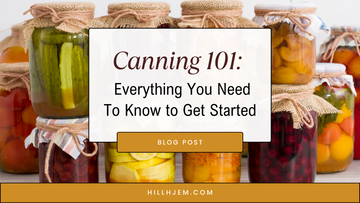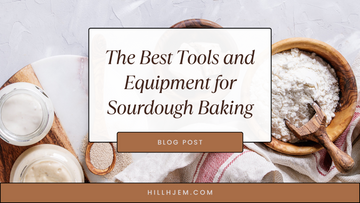
Remember that time you scored a basket overflowing with fresh summer berries on sale, then watched them slowly turn moldy in the fridge? Yeah, me too. That's what got me hooked on canning!
Not only did it slash our grocery bill (hello, fewer processed ingredients!), but it opened a door to preserving seasonal abundance into a year-round pantry filled with delicious, homemade goodness.
This guide will walk you through everything you need to know about canning as a beginner, from safety essentials to equipments you’ll need to start.
The Science Behind Canning
Canning works by creating a shelf-stable environment for food. Here's the breakdown:
- Heat Treatment: High heat destroys enzymes and microorganisms that cause spoilage.
- Acidity: Acid in the food (either naturally occurring or added through acidifiers like lemon juice or vinegar) inhibits the growth of harmful bacteria like botulism.
- Air Removal: Sealing the jar with a lid removes air, creating a vacuum seal. This lack of oxygen further hinders the growth of unwanted bacteria and ensures your food stays shelf-stable for months to come.

Photo by Ray Shrewsberry on Unsplash
There are two main canning methods:
1. Water Bath Canning
This gentle method is ideal for beginners and high-acid foods like fruits, jams, and pickles. Jars are submerged in boiling water, destroying bacteria and preserving the food. The natural acidity in these foods provides additional protection.
2. Pressure Canning
This method is the heavyweight champ for preserving low-acid foods like vegetables, meat, and seafood. A specialized pressure canner uses steam to create an intense, high-temperature environment that destroys harmful bacteria in these foods.
Canning Safety Essentials
While canning is a great way to preserve food, improper procedures can be dangerous. Here are some crucial points to remember for safe canning:
1. Use Tested Recipes
Only follow recipes developed and tested by reputable sources. These recipes ensure proper processing times and acidity levels for safe storage.
2. Acidity Matters
For water bath canning, stick to fruits and vegetables naturally high in acid, like tomatoes, berries, and peaches. These foods have a built-in defense against harmful bacteria. If you're unsure about the acidity of a food, or the recipe doesn't call for a high-acid ingredient, follow recipes that incorporate safe acidifiers like lemon juice or vinegar.
3. Fresh Starts
Invest in new lids and jars specifically designed for canning. Reusing lids can compromise the seal, potentially leading to spoilage and wasted food (not to mention the risk of illness). Think of it as a small investment in ensuring the safety and success of your canning endeavors.
4. Respect the Time
Processing time is not a suggestion – it's crucial for safe food. Processing times vary depending on the food and altitude. Don't be tempted to shorten the recommended processing time to save time. It's the duration needed to ensure the complete destruction of harmful bacteria that could cause illness.
Canning Equipments You’ll Need:
Now, let's gather the tools you'll need for your canning experience:
- Canning Pot: A large pot with a tight-fitting lid to hold enough water to completely submerge your jars during processing.
- Canning Rack: This elevated rack prevents jars from touching the bottom of the pot and prevents cracking.
- Canning Tongs: Long tongs specifically designed to safely grab hot jars from boiling water.
- Jar Lifter: This tool helps you safely remove submerged jars from the hot water bath.
- Headspace Tool: Ensures consistent headspace (the space between the food and the rim of the jar) for proper sealing.
- Canning Funnel: Prevents spills and mess while filling jars with hot liquids.
- Bubble Popper: Removes air bubbles trapped in the filled jars for a better seal.
- Lids and Bands: New lids and screw bands are crucial for each canning session.
Optional, but useful canning equipments:
- Pressure Canner: While not essential for beginners focusing on water bath canning, a pressure canner opens up a wider range of foods you can preserve, like vegetables, meat, and seafood.
- Magnetic Lid Lifter: This handy tool uses a magnet to grab lids from hot water, keeping your fingers safely away from the heat.
- Canning Timer: Forgetting to check the time can be disastrous. A dedicated canning timer can help ensure you follow processing times precisely.
Canning might seem intimidating at first, but with the right knowledge and equipment, you can easily conquer this skill that unlocks a world of homemade goodness. Plus, there's something incredibly rewarding about opening a jar you filled yourself, knowing you created that healthy food for your family.
So, ditch the store-bought and give canning a try! You might be surprised at how much fun (and fridge space!) you’ll save. And hey, if this busy mom can do it, you totally can too!
The good news?
We'll also be launching our amazing 9-in-1 Canning Kit soon, making learning the art of canning easier and more fun than ever! Stay tuned!




